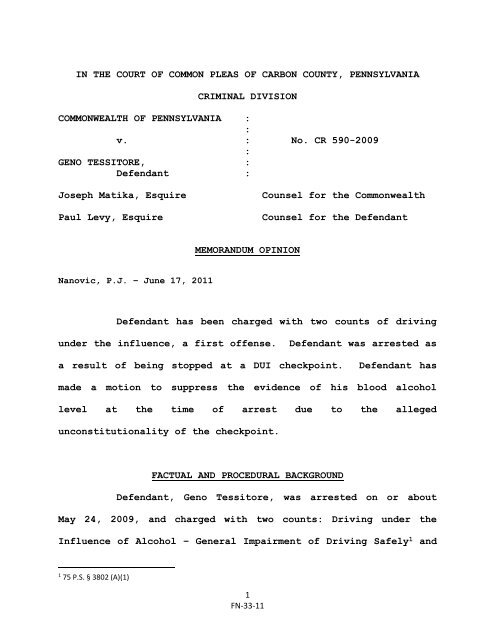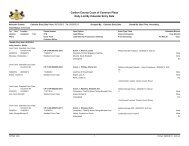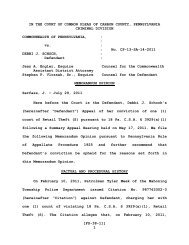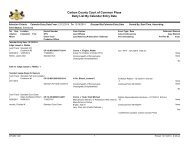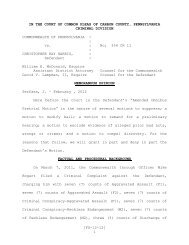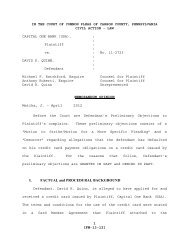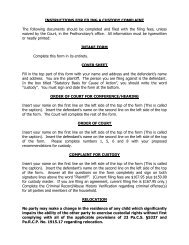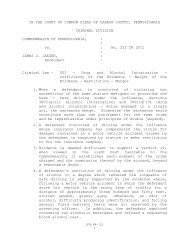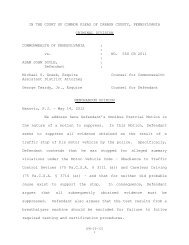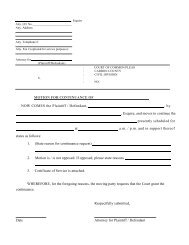in the court of common pleas of carbon county, pennsylvania
in the court of common pleas of carbon county, pennsylvania
in the court of common pleas of carbon county, pennsylvania
Create successful ePaper yourself
Turn your PDF publications into a flip-book with our unique Google optimized e-Paper software.
IN THE COURT OF COMMON PLEAS OF CARBON COUNTY, PENNSYLVANIACRIMINAL DIVISIONCOMMONWEALTH OF PENNSYLVANIA ::v. : No. CR 590-2009:GENO TESSITORE, :Defendant :Joseph Matika, EsquirePaul Levy, EsquireCounsel for <strong>the</strong> CommonwealthCounsel for <strong>the</strong> DefendantMEMORANDUM OPINIONNanovic, P.J. – June 17, 2011Defendant has been charged with two counts <strong>of</strong> driv<strong>in</strong>gunder <strong>the</strong> <strong>in</strong>fluence, a first <strong>of</strong>fense. Defendant was arrested asa result <strong>of</strong> be<strong>in</strong>g stopped at a DUI checkpo<strong>in</strong>t.Defendant hasmade a motion to suppress <strong>the</strong> evidence <strong>of</strong> his blood alcohollevel at <strong>the</strong> time <strong>of</strong> arrest due to <strong>the</strong> allegedunconstitutionality <strong>of</strong> <strong>the</strong> checkpo<strong>in</strong>t.FACTUAL AND PROCEDURAL BACKGROUNDDefendant, Geno Tessitore, was arrested on or aboutMay 24, 2009, and charged with two counts: Driv<strong>in</strong>g under <strong>the</strong>Influence <strong>of</strong> Alcohol – General Impairment <strong>of</strong> Driv<strong>in</strong>g Safely 1 and175 P.S. § 3802 (A)(1)1FN-33-11
Driv<strong>in</strong>g under <strong>the</strong> Influence <strong>of</strong> Alcohol – General Impairment (BAC.08-.10). 2 The arrest occurred on Mauch Chunk Street, Mahon<strong>in</strong>gTownship, Carbon County, Pennsylvania at a DUI checkpo<strong>in</strong>tlocated at <strong>the</strong> former location <strong>of</strong> <strong>the</strong> Big Chief Restaurant atapproximately 1:40 a.m.Defendant was driv<strong>in</strong>g northbound on Mauch Chunk Street(S.R. 209) <strong>in</strong> a 1998 GMC vehicle bear<strong>in</strong>g a Pennsylvaniaregistration <strong>of</strong> GNE6149.companion <strong>in</strong> <strong>the</strong> car.Defendant was travel<strong>in</strong>g with a femaleDefendant was stopped <strong>in</strong> Mahon<strong>in</strong>gTownship by an <strong>of</strong>ficer who waved him <strong>in</strong>to <strong>the</strong> sobrietycheckpo<strong>in</strong>t.While <strong>in</strong> <strong>the</strong> checkpo<strong>in</strong>t, an <strong>of</strong>ficer detected anodor <strong>of</strong> alcohol com<strong>in</strong>g from <strong>the</strong> vehicle. The Defendant was <strong>the</strong>nasked to perform several field sobriety tests - f<strong>in</strong>ger to nose,one leg stand, n<strong>in</strong>e step heel to toe, and prelim<strong>in</strong>ary breathtest.Defendant failed <strong>the</strong>se tests and was <strong>the</strong>n placed underarrest and submitted to a blood test.The sample was drawn at1:55 hours and yielded a BAC <strong>of</strong> .094%The Defendant, through his attorney Paul Levy, Esq.,has filed an Omnibus Pre-trial Motion which seeks suppression <strong>of</strong><strong>the</strong> evidence <strong>of</strong> his blood alcohol level due to allegedconstitutional violations regard<strong>in</strong>g <strong>the</strong> checkpo<strong>in</strong>t.Defendantalleges that <strong>the</strong> checkpo<strong>in</strong>t was unconstitutional due to a lack275 P.S. § 3802 (A)(2)2FN-33-11
<strong>of</strong> sufficient warn<strong>in</strong>g and lack <strong>of</strong> prior adm<strong>in</strong>istrative approval.The hear<strong>in</strong>g on this motion was held on November 12, 2010.The follow<strong>in</strong>g evidence was presented at <strong>the</strong> hear<strong>in</strong>g.Officer Audie Mertz who was <strong>in</strong> charge <strong>of</strong> <strong>the</strong> checkpo<strong>in</strong>ttestified for <strong>the</strong> Commonwealth and stated that <strong>the</strong> roadblock wasset up <strong>in</strong> compliance with all guidel<strong>in</strong>es, <strong>in</strong>clud<strong>in</strong>g <strong>the</strong> erection<strong>of</strong> required signage <strong>in</strong>form<strong>in</strong>g drivers <strong>of</strong> <strong>the</strong> roadblock.Accord<strong>in</strong>g to PennDOT’s DUI Law Enforcement Manual, <strong>the</strong>re must betwo signs visible to oncom<strong>in</strong>g drivers, one at four hundred feetand one at six hundred feet.Defendant asserted that <strong>the</strong>re wasonly one sign warn<strong>in</strong>g <strong>of</strong> <strong>the</strong> roadblock and that it was less than<strong>the</strong> required 400 feet from <strong>the</strong> checkpo<strong>in</strong>t. 3 In response, OfficerMertz testified for <strong>the</strong> Commonwealth that <strong>the</strong>re had been twosigns placed appropriately four hundred and six hundred feetbefore <strong>the</strong> checkpo<strong>in</strong>t.The Officer testified that he measuredout <strong>the</strong> distances and had o<strong>the</strong>r <strong>of</strong>ficers place <strong>the</strong> signs at<strong>the</strong>se distances.The Officer also testified that sufficientnotice <strong>of</strong> possible locations <strong>of</strong> <strong>the</strong> checkpo<strong>in</strong>t was provided <strong>in</strong><strong>the</strong> form <strong>of</strong> a press release <strong>in</strong> advance to <strong>the</strong> local news media.The Officer was unsure if such <strong>in</strong>formation was actuallypublished but testified that he did provide such <strong>in</strong>formation to<strong>the</strong> media.3The Defendant asserted that <strong>the</strong> sign was at most 300 feet before <strong>the</strong> checkpo<strong>in</strong>t.3FN-33-11
Defendant also challenges <strong>the</strong> checkpo<strong>in</strong>t on <strong>the</strong> basis<strong>of</strong> a lack <strong>of</strong> prior adm<strong>in</strong>istrative approval.Officer Mertztestified that he is a traffic safety coord<strong>in</strong>ator, as appo<strong>in</strong>tedby <strong>the</strong> Chief <strong>of</strong> Police on September 1, 2008, and had <strong>in</strong>herentpower through that position to conduct sobriety checkpo<strong>in</strong>tsthroughout <strong>the</strong> township.Therefore it is <strong>the</strong> Commonwealth’sposition that no fur<strong>the</strong>r adm<strong>in</strong>istrative approval was necessary.Follow<strong>in</strong>g <strong>the</strong> hear<strong>in</strong>g, <strong>the</strong> parties asked for <strong>the</strong>opportunity to submit briefs on <strong>the</strong> matter which was granted.The sole issue before us is whe<strong>the</strong>r <strong>the</strong> sobriety checkpo<strong>in</strong>t wasconstitutionally permitted, <strong>the</strong> lynchp<strong>in</strong> <strong>of</strong> Defendant’s motionto suppress.DISCUSSIONDefendant challenges <strong>the</strong> constitutionality <strong>of</strong> <strong>the</strong>traffic stop which resulted <strong>in</strong> <strong>the</strong> DUI charges now pend<strong>in</strong>gaga<strong>in</strong>st him.Defendant’s challenge is based on <strong>the</strong> sufficiency<strong>of</strong> <strong>the</strong> warn<strong>in</strong>g <strong>of</strong> <strong>the</strong> checkpo<strong>in</strong>t, and an alleged lack <strong>of</strong> prioradm<strong>in</strong>istrative approval <strong>of</strong> <strong>the</strong> checkpo<strong>in</strong>t.[T]he conduct <strong>of</strong> <strong>the</strong> roadblock itself can besuch that it requires only a momentary stopto allow <strong>the</strong> police to make a brief buttra<strong>in</strong>ed observation <strong>of</strong> a vehicle's driver,without entail<strong>in</strong>g any physical search <strong>of</strong> <strong>the</strong>vehicle or its occupants. To avoidunnecessary surprise to motorists, <strong>the</strong>4FN-33-11
existence <strong>of</strong> a roadblock can be so conductedas to be ascerta<strong>in</strong>able from a reasonabledistance or o<strong>the</strong>rwise made knowable <strong>in</strong>advance. The possibility <strong>of</strong> arbitraryroadblocks can be significantly curtailed by<strong>the</strong> <strong>in</strong>stitution <strong>of</strong> certa<strong>in</strong> safeguards. First<strong>the</strong> very decision to hold a drunk-driverroadblock, as well as <strong>the</strong> decision as to itstime and place, should be matters reservedfor prior adm<strong>in</strong>istrative approval, thusremov<strong>in</strong>g <strong>the</strong> determ<strong>in</strong>ation <strong>of</strong> those mattersfrom <strong>the</strong> discretion <strong>of</strong> police <strong>of</strong>ficers <strong>in</strong> <strong>the</strong>field. In this connection it is essentialthat <strong>the</strong> route selected for <strong>the</strong> roadblock beone which, based on local experience, islikely to be travelled by <strong>in</strong>toxicateddrivers. The time <strong>of</strong> <strong>the</strong> roadblock should begoverned by <strong>the</strong> same consideration.Additionally, <strong>the</strong> question <strong>of</strong> which vehiclesto stop at <strong>the</strong> roadblock should not be leftto <strong>the</strong> unfettered discretion <strong>of</strong> police<strong>of</strong>ficers at <strong>the</strong> scene, but <strong>in</strong>stead should be<strong>in</strong> accordance with objective standardsprefixed by adm<strong>in</strong>istrative decision...Substantial compliance with <strong>the</strong> guidel<strong>in</strong>es isall that is required to reduce <strong>the</strong><strong>in</strong>trusiveness <strong>of</strong> <strong>the</strong> search to aconstitutionally acceptable level. Tarbert,517 Pa. at 293, 535 A.2d at 1043.Commonwealth v. Blouse, 611 A.2d 1177, 1180 (Pa.1992).Thesestandards must be substantially complied with <strong>in</strong> order for aroadblock to survive constitutional scrut<strong>in</strong>y. See id. “Theprecise issue <strong>of</strong> whe<strong>the</strong>r drunken driver roadblocks wereconstitutional under our state Constitution eluded <strong>the</strong> Court <strong>in</strong>Tarbert. However, ‘it is clear that <strong>of</strong> <strong>the</strong> six [justices] whoparticipated [<strong>in</strong> Tarbert], four [justices] expressed <strong>the</strong> viewthat systematic roadblocks are constitutional.’”Commonwealth5FN-33-11
v. Yastrop, 768 A.2d 318, 321 (Pa. 2001) (cit<strong>in</strong>g Blouse, 611A.2d at 1179)(extend<strong>in</strong>g <strong>the</strong> constitutionality <strong>of</strong> systematicroadblocks to those aimed at deta<strong>in</strong><strong>in</strong>g and discourag<strong>in</strong>g drunkdrivers).To be constitutionally valid, <strong>the</strong> Court must f<strong>in</strong>dthat <strong>the</strong> checkpo<strong>in</strong>t substantially complied with <strong>the</strong> Tarbert-Blouse factors. See id. at 323. If this standard is not met,evidence ga<strong>in</strong>ed from <strong>the</strong> checkpo<strong>in</strong>t must be suppressed.Accord<strong>in</strong>gly, it is aga<strong>in</strong>st <strong>the</strong> Tarbert-Blouse factors by whichconstitutionality <strong>in</strong> <strong>the</strong> context <strong>of</strong> substantial compliance ismeasured.1. The stop <strong>of</strong> a vehicle at a checkpo<strong>in</strong>t must bebrief and not entail a physical search.See Tarbert, 535 A.2dat 1043; see also Blouse, 611 A.2d at 1180.Here <strong>the</strong> <strong>in</strong>itial stop was brief.The Defendant wasstopped and asked a few questions. After detect<strong>in</strong>g alcohol, <strong>the</strong>Officer directed <strong>the</strong> Defendant to pull over and perform <strong>the</strong>field sobriety tests.vehicle prior to arrest.No physical search was done <strong>of</strong> <strong>the</strong>The <strong>in</strong>itial stop and question<strong>in</strong>g wasbrief, sobriety tests were only adm<strong>in</strong>istered after detect<strong>in</strong>g <strong>the</strong>odor <strong>of</strong> alcohol on <strong>the</strong> Defendant giv<strong>in</strong>g <strong>the</strong> Officer probablecause to deta<strong>in</strong> <strong>the</strong> Defendant longer.6FN-33-11
2. Motorists must be given sufficient warn<strong>in</strong>g <strong>of</strong> <strong>the</strong>existence <strong>of</strong> <strong>the</strong> checkpo<strong>in</strong>t. See Tarbert, 535 A.2d at 1043; seealso Blouse, 611 A.2d at 1180.A press release was provided to local news mediagiv<strong>in</strong>g <strong>in</strong>formation about potential times and places for <strong>the</strong>checkpo<strong>in</strong>t.It is immaterial that <strong>the</strong> press release <strong>in</strong>cludedadditional locations beyond <strong>the</strong> primary two sites for <strong>the</strong>checkpo<strong>in</strong>t as <strong>the</strong> location and time <strong>of</strong> <strong>the</strong> checkpo<strong>in</strong>t wascovered with<strong>in</strong> <strong>the</strong> release.The burden is not on <strong>the</strong>Commonwealth to make sure that <strong>the</strong> press release is actuallypublished, show<strong>in</strong>g that a press release was issued issufficient.In Commonwealth v Rastogi, a defendant challenged <strong>the</strong>validity <strong>of</strong> a checkpo<strong>in</strong>t <strong>in</strong> part because <strong>the</strong>re was no evidencethat a press release was ever published or broadcast. The cour<strong>the</strong>ld that actual publication or broadcast <strong>of</strong> <strong>the</strong> press releaseis not required to make <strong>the</strong> checkpo<strong>in</strong>t constitutional. See 816A.2d 1191, 1195 (Pa.Super. 2003).In fact, “[n]ei<strong>the</strong>r Blousenor Tarbert mandate that <strong>the</strong> police must place advance notice <strong>of</strong><strong>the</strong> DUI checkpo<strong>in</strong>t <strong>in</strong> any local or regional publication.”Id.(citation omitted).The Court also accepts <strong>the</strong> testimony <strong>of</strong> Officer Mertzthat <strong>the</strong> signs for <strong>the</strong> checkpo<strong>in</strong>t were properly placed at 400and 600 feet, respectively.A diagram <strong>of</strong> <strong>the</strong> layout <strong>of</strong> <strong>the</strong>7FN-33-11
checkpo<strong>in</strong>t was provided at <strong>the</strong> hear<strong>in</strong>g.Although <strong>the</strong> diagramwas not to scale, it depicted an appropriate layout with twosigns warn<strong>in</strong>g <strong>of</strong> <strong>the</strong> checkpo<strong>in</strong>t.Additionally as far asadequate notice <strong>of</strong> <strong>the</strong> stop is concerned “[a] sign <strong>in</strong>dicat<strong>in</strong>gthat <strong>the</strong> motorist is about to be stopped and suggest<strong>in</strong>g <strong>the</strong>nature <strong>of</strong> <strong>the</strong> stop may provide advance warn<strong>in</strong>g <strong>of</strong> <strong>the</strong>roadblock.” Tarbert, 535 A.2d at 1041.At <strong>the</strong> time <strong>of</strong> <strong>the</strong> hear<strong>in</strong>g <strong>the</strong> defense argued that<strong>the</strong>re was no place for a northbound driver to make a lawful “Uturn” after see<strong>in</strong>g signage for <strong>the</strong> checkpo<strong>in</strong>t. The Commonwealthasserted that a northbound driver could have executed a lawful“U turn” <strong>in</strong> <strong>the</strong> park<strong>in</strong>g lot where <strong>the</strong> DUI checkpo<strong>in</strong>t waslocated.Few, if any, drivers would believe that a “U turn”could be executed <strong>in</strong> <strong>the</strong> very park<strong>in</strong>g lot where a checkpo<strong>in</strong>t islocated. However, due to <strong>the</strong> o<strong>the</strong>rwise adequate warn<strong>in</strong>gs <strong>of</strong> <strong>the</strong>checkpo<strong>in</strong>t through press release and signage, and <strong>the</strong> fact that“nei<strong>the</strong>r Blouse nor Tarbert suggest that motorists approach<strong>in</strong>g aDUI checkpo<strong>in</strong>t must be afforded an opportunity to avoid <strong>the</strong>checkpo<strong>in</strong>t,” this is not a controll<strong>in</strong>g issue and will not leadto suppression <strong>of</strong> <strong>the</strong> evidence. Id.3. The decision to conduct a checkpo<strong>in</strong>t, <strong>in</strong>clud<strong>in</strong>g<strong>the</strong> decision as to <strong>the</strong> time and <strong>the</strong> place for <strong>the</strong> checkpo<strong>in</strong>tmust be subject to prior adm<strong>in</strong>istrative approval.See Tarbert,535 A.2d at 1043; see also Blouse, 611 A.2d at 1180.8FN-33-11
Testimony showed that Officer Mertz, who organized <strong>the</strong>checkpo<strong>in</strong>t, was a traffic safety coord<strong>in</strong>ator for Mahon<strong>in</strong>gTownship.It was stated that <strong>in</strong>herent <strong>in</strong> his position is <strong>the</strong>authority to schedule and conduct checkpo<strong>in</strong>ts.The harm to beavoided by requir<strong>in</strong>g adm<strong>in</strong>istrative approval <strong>of</strong> checkpo<strong>in</strong>ts isto remove <strong>the</strong> possibility <strong>of</strong> random, unplanned, and unorganizedcheckpo<strong>in</strong>ts for both constitutional and safety concerns.Here<strong>the</strong> checkpo<strong>in</strong>t was clearly planned out and clearly organized.Officer Mertz was given authority by <strong>the</strong> township to plan suchcheckpo<strong>in</strong>ts. We cannot say that this authority isconstitutionally unfounded as precautions were taken to avoid<strong>the</strong> possible dangers <strong>of</strong> “surprise” checkpo<strong>in</strong>ts.The checkpo<strong>in</strong>twas organized with safety concerns <strong>in</strong> m<strong>in</strong>d and sufficientwarn<strong>in</strong>g was given to put drivers on notice that a checkpo<strong>in</strong>twould occur.4. The time and place for a checkpo<strong>in</strong>t must be basedon local experience as to where and when <strong>in</strong>toxicated drivers arelikely to be travel<strong>in</strong>g. See Tarbert, 535 A.2d at 1043; see alsoBlouse, 611 A.2d at 1180.Testimony showed that Officer Mertz studiedstatistical data from both Mahon<strong>in</strong>g Township and PennDOT show<strong>in</strong>gthat <strong>the</strong> location chosen was one likely to be travelled by<strong>in</strong>toxicated drivers.Officer Mertz reasonably relied on this<strong>in</strong>formation <strong>in</strong> determ<strong>in</strong><strong>in</strong>g that <strong>the</strong> location and time <strong>of</strong> <strong>the</strong>9FN-33-11
checkpo<strong>in</strong>t would be well calculated for <strong>the</strong> purpose <strong>of</strong> asobriety checkpo<strong>in</strong>t. Both <strong>the</strong> location and time for <strong>the</strong>roadblock followed statistical data accord<strong>in</strong>g to <strong>the</strong> <strong>of</strong>ficer’stestimony.5. The decision as to which vehicles are stopped mustbe established by an adm<strong>in</strong>istratively, pre-fixed, objectivestandard and not be left to <strong>the</strong> discretion <strong>of</strong> <strong>the</strong> <strong>of</strong>ficers at<strong>the</strong> checkpo<strong>in</strong>t.See Tarbert, 535 A.2d at 1043; see alsoBlouse, 611 A.2d at 1180.In <strong>the</strong> <strong>in</strong>stant case, every <strong>of</strong>ficer <strong>in</strong>volved was issueda “Standard Operat<strong>in</strong>g Procedure” which stated <strong>the</strong> purpose <strong>of</strong> <strong>the</strong>checkpo<strong>in</strong>t, <strong>the</strong> site, implementation, and deta<strong>in</strong>ment proceduresfor vehicles at <strong>the</strong> checkpo<strong>in</strong>t.Only <strong>the</strong> Coord<strong>in</strong>ator wasallowed to deviate from <strong>the</strong> “Standard Operat<strong>in</strong>g Procedure.”Every vehicle enter<strong>in</strong>g <strong>the</strong> checkpo<strong>in</strong>t was stopped with oneexception: if traffic became unreasonably backed up, twenty carswould be allowed to pass through to alleviate congestion.Thisis allowed under Commonwealth v. Worthy, 957 A.2d 720, 725-26(Pa. 2008).The testimony showed that <strong>the</strong> plan for vehiclestoppage was laid out prior to implementation <strong>of</strong> <strong>the</strong> checkpo<strong>in</strong>t.The <strong>of</strong>ficers had no discretion as to which vehicles to stop andhow to proceed once stopped.Accord<strong>in</strong>gly, this factor <strong>of</strong> <strong>the</strong>Tarbert-Blouse test has been met.10FN-33-11
Hav<strong>in</strong>g found that all <strong>the</strong> factors for a checkpo<strong>in</strong>t tobe constitutionally permissible were substantially compliedwith, we f<strong>in</strong>d that <strong>the</strong>re were no constitutional violations suchthat <strong>the</strong> evidence aga<strong>in</strong>st <strong>the</strong> Defendant should be suppressed.CONCLUSIONIn accordance with <strong>the</strong> forego<strong>in</strong>g, Defendant’s Motionto Suppress will be denied.BY THE COURT___________________P.J.11FN-33-11
IN THE COURT OF COMMON PLEAS OF CARBON COUNTY, PENNSYLVANIACRIMINAL DIVISIONCOMMONWEALTH OF PENNSYLVANIA ::v. : No. CR 590-2009:GENO TESSITORE, :Defendant :Joseph Matika, EsquirePaul Levy, EsquireCounsel for <strong>the</strong> CommonwealthCounsel for <strong>the</strong> DefendantORDERAND NOW, this 17th day <strong>of</strong> June, 2011, uponconsideration <strong>of</strong> <strong>the</strong> Defendant’s, GENO TESSITORE, OmnibusPretrial Motion, and <strong>in</strong> consideration <strong>of</strong> <strong>the</strong> parties’submissions <strong>the</strong>reto and <strong>the</strong> argument <strong>the</strong>reon, it is herebyORDERED and DECREED that Defendant’s Motion toSuppress is DISMISSED and DENIED.BY THE COURT___________________P.J.12FN-33-11


